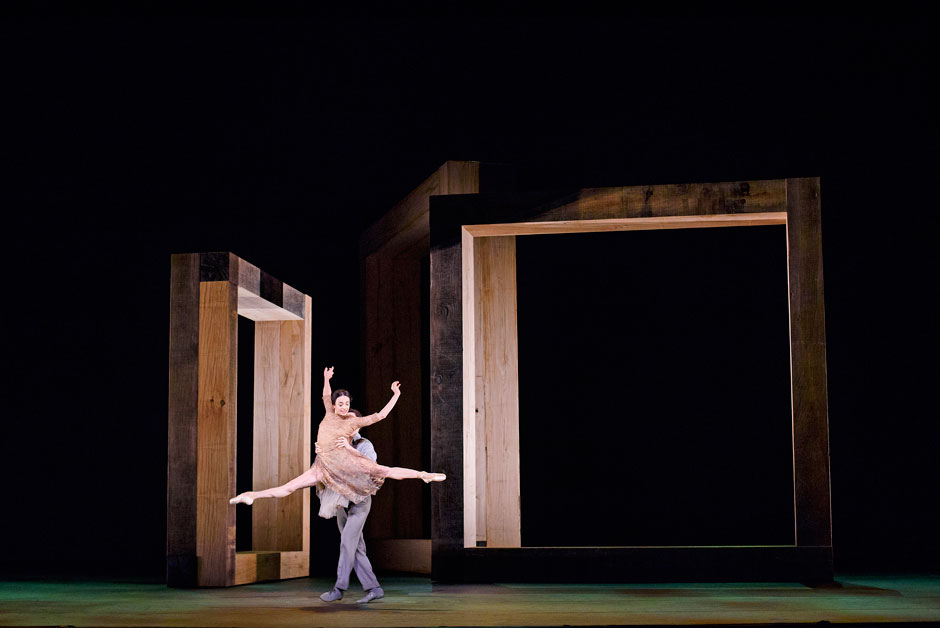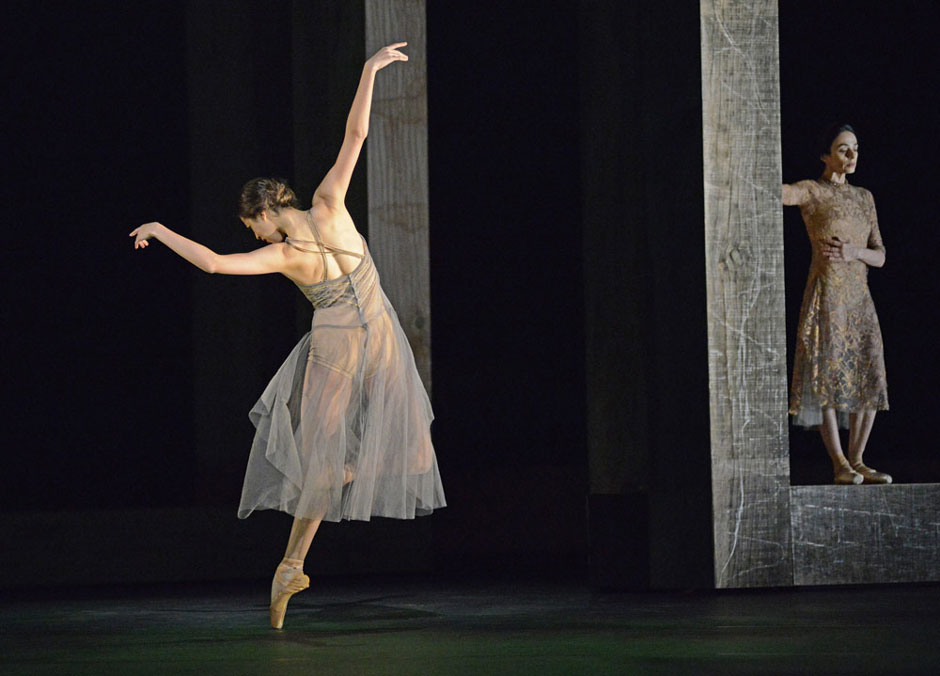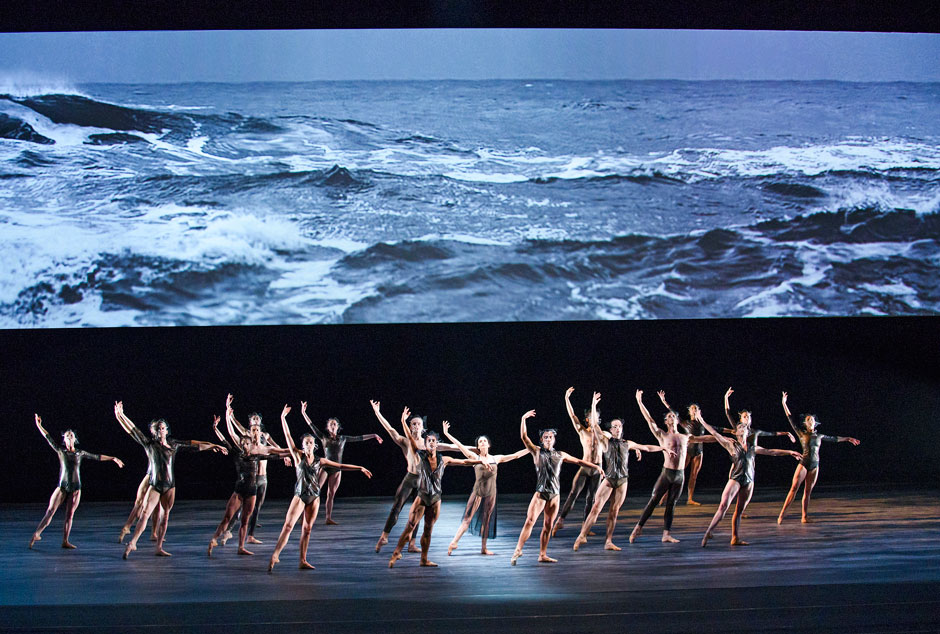Should a ballet be about something? George Balanchine, the greatest choreographer in the art, believed that ballet needed no external subject to give it meaning: We can’t dance synonyms, he liked to say. But one major part of the history of ballet, of course, is a history of attempts at various synonyms, ever since the Ballet comique de la reine in 1581 depicted Circe vanquished by Minerva and Jupiter. The story-ballet is one of ballet’s most famous modes—even if its success in conveying narrative is precarious. In the eighteenth century, Jean-Georges Noverre maintained that his system of “living tableaux” could tell a story better than words, but even Noverre had his doubts. When he put on his five-act ballet, Les Horaces et les Curiaces, based on a tragedy by Corneille, he also published a thirteen-page accompanying program, for those who didn’t already know the plot of Corneille’s play.
Balanchine himself, of course, preferred a more pristine formality, but more recent choreographers have still been tempted by the lure of dancing synonyms, and one of the most interesting is Wayne McGregor. Over the past decade, the British choreographer has moved between dances of high abstraction, like Infra (2008) or Limen (2009), to dances that explore violently unballetic subject matter—neuroscience, eighteenth-century history, and now modernist fiction. His new ballet, Woolf Works, which is derived from, or based on—the verbs being precisely the problem—three novels by Virginia Woolf, recently premiered at Covent Garden in London. It is a brilliant, uneven, tender piece—and it offers one way of thinking about this constant conundrum for the art of ballet.
Woolf’s writing is its own reality, and in Woolf Works McGregor has come up with three provisional solutions to the way ballet might hint at its implications, letting ballet emerge from the fiction’s philosophical investigations, rather than simply depicting a plot. But what therefore might this practically mean? Woolf Works, with a score by Max Richter, is advertized as McGregor’s first full-length ballet for the Royal Ballet, where he’s been Resident Choreographer since 2006. Its subtitle, however, offers the looser definition of “A Triptych”—and the three parts occupy relatively separate worlds, each one departing from a different novel by Woolf. The first, “I Now, I Then,” is after Mrs. Dalloway; the second, “Becomings,” from Orlando; and the third, “Tuesday,” from The Waves.
McGregor also includes two recordings of Virginia Woolf reading her work, neither from her fiction. The ballet begins with Woolf’s 1937 reading for the BBC of her essay “On Craftsmanship”—a small investigation of literature as history: “Words, English words, are full of echoes, memories, associations…” While the final act, “Tuesday,” opens on a reading by Gillian Anderson of Woolf’s letter to her husband Leonard, before her suicide, written on March 28, 1941: “Dearest, I feel certain that I am going mad again. I feel we can’t go through another of those terrible times…”
The readings are meant to create an overlap between Woolf and her fictions, and they’re a clue that McGregor isn’t interested in anything so direct as an adaptation. Woolf’s genius, after all, was for shifts and movements. She is the great writer of the sudden mood change, or the way different time frames coalesce—“the moment of this June morning on which was the pressure of all the other mornings.” And McGregor’s ideal is a ballet that is equally agile. The most concrete example is offered by the first part, “I now, I then,” after Mrs. Dalloway. In a diary entry of 1923 Woolf famously described one of her innovations: “My discovery: how I dig out beautiful caves behind my characters… The idea is that the caves shall connect, & each comes to daylight at the present moment.” She wanted a method for representing how the past and present might interpenetrate, and she envied cinema for its greater fluency—“The past could be unrolled, distances annihilated…”
But it’s arguable that ballet can be even more fluid. There’s a lovely, melancholy moment where Alessandra Ferri, who is now fifty-two, dances with Francesca Hayward, who is twenty-three. Ferri is playing a hybrid version of Mrs. Dalloway and Woolf herself, while Hayward is playing Mrs. Dalloway’s girlhood friend, Sally. In the novel, there is this moment of reminiscence:
Then came the most exquisite moment of her whole life passing a stone urn with flowers in it. Sally stopped; picked a flower; kissed her on the lips. The whole world might have turned upside down! The others disappeared; there she was alone with Sally. And she felt that she had been given a present, wrapped up, and told just to keep it, not to look at it—a diamond, something infinitely precious, wrapped up, which, as they walked (up and down, up and down), she uncovered, or the radiance burnt through, the revelation, the religious feeling!
Sure, there is no way in dance of conveying the precision of Mrs. Dalloway’s revelation, that simile of the wrapped diamond. It exists only in language. But it is ballet and not the novel that can most elegantly stage the kind of interpenetration of time frames which Woolf wanted. Flashback or reminiscence is often clumsy in literature. Whereas that dance of Ferri with Hayward, where a person physically replaces her past self, is infinitely moving in its conceptual impossibility.
Advertisement
And of course, there’s another way the past and present interpenetrate, in the figure of Alessandra Ferri herself. I remember the filmmaker Pawel Pawlikowski once observing that the most revealing test of a film director’s talent was in the casting, and that talent is evident in McGregor’s choice of Ferri. For not only is she a dancer of anguished gracefulness. She also incarnates a history. She began her career at the Royal Ballet, under Kenneth MacMillan. Then, in 1985, aged twenty-one, a year after she’d been made a Principal, she left for the American Ballet Theatre. Apart from one brief return in MacMillan’s Romeo and Juliet, this is her first performance on the Royal Ballet stage since then. “You can see why Alessandra was MacMillan’s muse,” McGregor is quoted in the ballet’s program, “and I love the idea that she has had a history here; then there has been an absence. Given that Woolf’s work was so much about reconstructing memory, there’s something to explore in that.” Ferri, in other words, has her own beautiful cave behind her, and it creates a subtle effect of its own, simply through her presence on stage.
McGregor, however, has always been wary of emotion. His sets are often video projections, or laser beams, ruthless in their flatness; his ballets, concentrating more on ensembles than pas de deux, are made from small hand-flicks, jagged movements—and a certain inward-facing bodily stance that began with Nijinsky. His talent is for a sinuous awkwardness (it’s interesting to watch videos of him rehearsing Woolf Works, where one preoccupation is how to make the transitions between movements and poses more fluid). And it’s that style which is most visible in the ballet’s second act, “Becomings,” after Orlando.
“Becomings” resembles Woolf’s novel of time travel and sex change only at the most general level—figured bluntly in the costumes: the dancers are in a kind of futuristic eighteenth-century outfit, like the end of 2001, and the men wear tutus… But how, after all, can a ballet depict the poised campness of Woolf’s pastiche—or offer a metamorphosis as elegant as this? “He stretched himself. He rose. He stood upright in complete nakedness before us, and while the trumpets pealed Truth! Truth! Truth! we have no choice left but confess—he was a woman.” Like Mrs. Dalloway’s simile of the wrapped diamond, these are pure phenomena of language. Instead, McGregor’s “Becomings” is an ensemble piece from which couples emerge, swapping partners, indifferent to gender, before returning to the group. It is a purified abstraction, of undeniable beauty, but it is only a machine for the unfolding of McGregor’s style. The ballet’s dramaturge, Uzma Hameed, has written that “we wanted watching the ballet to feel like reading Woolf.” The limits of that ambition are proved most clearly in “Becomings.” Watching it feels only like watching a ballet by Wayne McGregor.
But then, why should ballet even try such an impossible ideal? Why be tempted by synonyms? Ballet’s true meanings, I think, are elsewhere—and it is in the last act, “Tuesday,” based on The Waves, where its true mechanism emerges most obviously. The act returns to the central pairing of Alessandra Ferri and Federico Bonelli that had begun “I now, I then.” True, the backdrop is pure literalist crudity—a video projection of waves; and the recording of Woolf’s suicide note is an artistic gaucheness of a different kind. But the dance itself, and in particular the pas de deux between Ferri and Bonelli, has a weary, elongated beauty. It is a dance where weight is transferred between the two dancers, so that Ferri’s body shifts often unbearably between pure lightness and pure weight—at times arched in the most poised avian shapes, at other times a hunched bundle, carried by Bonelli across the stage.
Advertisement
It’s a dance of unusual poignancy for McGregor, and once again it seems partly released by Ferri’s history. The last time Ferri came back to Covent Garden was to dance in MacMillan’s Romeo and Juliet, and it was the death scene in that ballet where MacMillan famously exploited his love of messy realism, in the awkwardness of Juliet’s death. “Don’t be afraid to look ugly,” he famously advised Lynn Seymour, dancing Juliet. “You’re just a lump of dead meat.” That problem of weight haunts, I think, McGregor’s choreography of Ferri, and is the submerged reason for its accumulated beauty.
But MacMillan’s advice is also freighted with an ambition that is unsustainable. In Jennifer Homans’s book Apollo’s Angels, there’s a brilliant moment where she observes the weakness in MacMillan’s choreography, with its desire for a narrative realism that ballet cannot offer: “Classical ballet is an art of formal principles; take those away and it disintegrates into crude pantomime.” Pantomime has always been ballet’s gruesome twin—the danger of every narrative impulse. This was what Balanchine was resisting, with his pure choreography, and acidic aphorisms: “Put a man and a girl on stage and there is already a story; a man and two girls, there’s already a plot.” And in its best moments, McGregor’s choreography similarly seemed to resist its own initial narrative impulse—to settle instead on an examination of the bodies of his dancers.
This, it seems to me, is the true way in which ballet explores its synonyms: through the literal bodies of the dancers themselves. The mystery arises through a pragmatic attention to physical detail. It’s why casting is so important, and it’s a truth recognized subtly in the way a choreographer describes making a ballet on a dancer. The dancer is the ballet’s pivot. For there Ferri was. She wasn’t Mrs. Dalloway, or Virginia Woolf. Nor was she Juliet. Or rather, she could allude to all of these—she contained multitudes—but the allusions were only flourishes. Really, she was only herself, and that was everything.





